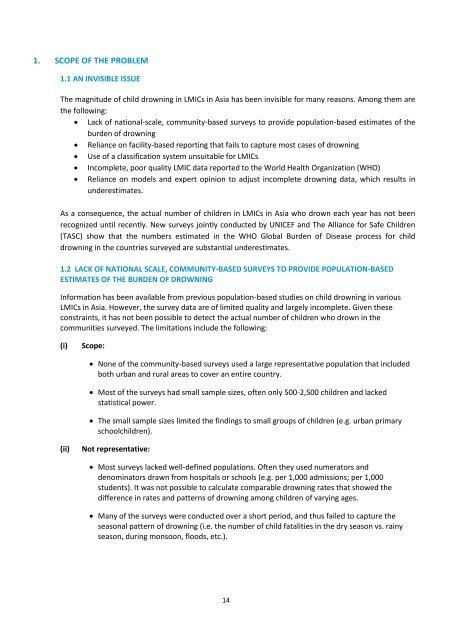Child Drowning
Child Drowning
Child Drowning
You also want an ePaper? Increase the reach of your titles
YUMPU automatically turns print PDFs into web optimized ePapers that Google loves.
1. SCOPE OF THE PROBLEM<br />
1.1 AN INVISIBLE ISSUE<br />
The magnitude of child drowning in LMICs in Asia has been invisible for many reasons. Among them are<br />
the following:<br />
Lack of national-scale, community-based surveys to provide population-based estimates of the<br />
burden of drowning<br />
Reliance on facility-based reporting that fails to capture most cases of drowning<br />
Use of a classification system unsuitable for LMICs<br />
Incomplete, poor quality LMIC data reported to the World Health Organization (WHO)<br />
Reliance on models and expert opinion to adjust incomplete drowning data, which results in<br />
underestimates.<br />
As a consequence, the actual number of children in LMICs in Asia who drown each year has not been<br />
recognized until recently. New surveys jointly conducted by UNICEF and The Alliance for Safe <strong>Child</strong>ren<br />
(TASC) show that the numbers estimated in the WHO Global Burden of Disease process for child<br />
drowning in the countries surveyed are substantial underestimates.<br />
1.2 LACK OF NATIONAL SCALE, COMMUNITY-BASED SURVEYS TO PROVIDE POPULATION-BASED<br />
ESTIMATES OF THE BURDEN OF DROWNING<br />
Information has been available from previous population-based studies on child drowning in various<br />
LMICs in Asia. However, the survey data are of limited quality and largely incomplete. Given these<br />
constraints, it has not been possible to detect the actual number of children who drown in the<br />
communities surveyed. The limitations include the following:<br />
(i)<br />
Scope:<br />
None of the community-based surveys used a large representative population that included<br />
both urban and rural areas to cover an entire country.<br />
Most of the surveys had small sample sizes, often only 500-2,500 children and lacked<br />
statistical power.<br />
The small sample sizes limited the findings to small groups of children (e.g. urban primary<br />
schoolchildren).<br />
(ii)<br />
Not representative:<br />
Most surveys lacked well-defined populations. Often they used numerators and<br />
denominators drawn from hospitals or schools (e.g. per 1,000 admissions; per 1,000<br />
students). It was not possible to calculate comparable drowning rates that showed the<br />
difference in rates and patterns of drowning among children of varying ages.<br />
Many of the surveys were conducted over a short period, and thus failed to capture the<br />
seasonal pattern of drowning (i.e. the number of child fatalities in the dry season vs. rainy<br />
season, during monsoon, floods, etc.).<br />
14

















